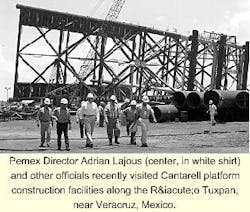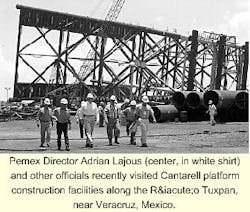Petroleos Mexicanos's long-term project to increase crude production at its huge offshore Cantarell complex, via a massive nitrogen injection enhanced recovery project, has come under unusual public scrutiny in recent weeks, following newspaper stories alleging work delays and corruption in the awarding of contracts.
Testimony by Pemex Director Adrian Lajous about the work under way at Cantarell, along with fact-finding trips to the project installations, appear to have convinced legislators that the allegations are unfounded. The government and congressional auditors have been investigating the project but have turned up no major wrongdoing. Project Director Antonio Acu?a and two other officials were suspended for 90 days, but their alleged infractions were described merely as ill-advised haste in awarding contracts to repair offshore infrastructure damaged by hurricanes in 1995, not for their work on Cantarell.
Lajous also defended Pemex's contracts with Bechtel, which acts both as Pemex's surface advisor as well as overall project administrator at Cantarell. The Bechtel contracts were awarded without a public bidding process, which has raised some suspicions in Mexico. Lajous said this was legally done, because at the time Pemex had a strong interest in not revealing details about the project and thus not disclosing news of Mexico's planned future crude production.
Pemex foresees spending $10.54 billion during 1997-2012 on the Cantarell project and expects the increased recovery to pay the costs of the project as well as provide a handsome profit. "The long-term development plan for this field predicts the recovery, over the next 15 years, of 8.4 billion bbl of crude, 2.2 times the amount that would have been recovered had the field declined naturally," Lajous told legislators.
Project update
In the congressional hearings, Lajous conceded that there had been some delays in the Cantarell project. "In a project of this great size, it's absolutely impossible, inconceivable, that the dates of the program are met exactly," Lajous said. However, he said that the development of Cantarell was staying very close to Pemex's plan and that any variations would not affect the project as a whole.
Of the 37 engineering, procurement, and construction contracts that make up the Cantarell project, 34 have been assigned through bidding, one is in the process of being assigned, and two remain to be bid. All 27 of the purchase orders for the project have been completed.
Much of the 400 km of new pipeline for the project has already been laid, including the pipeline for transporting nitrogen from the onshore nitrogen plant at Atasta to the Nohoch A platform in the Gulf of Campeche, where the gas will be injected into Cantarell. The nitrogen plant itself is due to come on line in April 2000, while the specialized injection platform is to be completed before the end of this year (see related story this page).
Seven new drilling platforms planned for Cantarell are currently under construction at the rig yards along the R!o Panuco and R!o Tuxpan on Mexico's Gulf of Campeche coast. Two are to be finished by the end of the year, and the remaining five during 2000. A special platform to compress and process natural gas offshore, which Lajous called the most complex structure of the entire Cantarell project, is to be built by early 2002.
Questioned on how Pemex plans to separate the nitrogen from Cantarell's produced natural gas, Lajous said the company plans to leave much of the reservoir's gas unexploited until most of the crude has been produced. "In twenty-some years, when we stop producing crude, we will start to exploit the cap of natural gas in the field, and at this time we will separate the nitrogen from the gas," Lajous said at a Senate hearing. "I guarantee that, in 25 years, the cost of doing this will be very low."
Gas unavoidably produced during the crude production phase will be mixed with natural gas produced elsewhere in Mexico to dilute the nitrogen content.
Cantarell status
Pemex has also begun significantly reducing the amount of associated gas it flares at Cantarell. From a peak of 490 MMcfd at Cantarell in November 1998, Pemex has reduced flaring to 261 MMcfd by June of this year. Lajous said Pemex plans to reach 100 MMcfd by November of this year.
After 19 years in production, Cantarell now produces at a rate of 1.271 million b/d of crude oil, with a potential production of 1.687 million b/d. Natural gas production this year has been roughly 500 MMcfd. The complex has produced about 7 billion boe since 1979, roughly a third of its combined proven and probable reserves.
The Cantarell reserves do not include the Sihil new-field discovery, directly underlying the main producing field, Cantarell, which was disclosed Mar. 18 and confirmed with follow-up drilling in late July (OGJ, Aug. 30, 1999, Newsletter). An initial exploratory well flowed on test at a rate of 5,200 b/d of Maya-grade crude, as well as 1.85 MMcfd of gas. According to its latest data, Pemex estimates Sihil contains 1.412 billion boe. Further appraisal drilling of Sihil is planned later this year.



